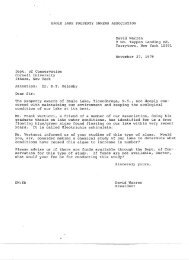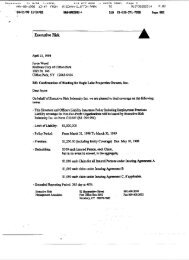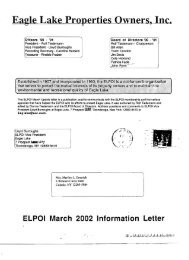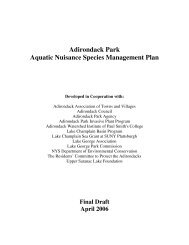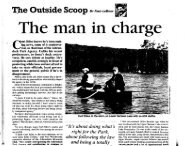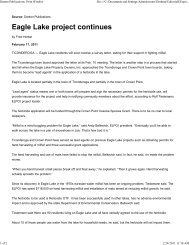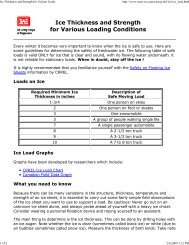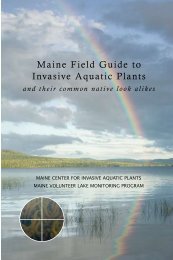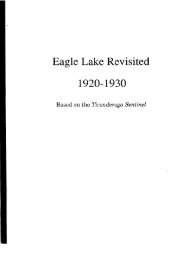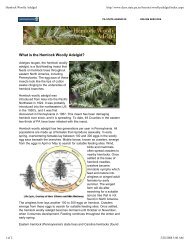SEIS - Eagle Lake Property Owner's Inc.
SEIS - Eagle Lake Property Owner's Inc.
SEIS - Eagle Lake Property Owner's Inc.
Create successful ePaper yourself
Turn your PDF publications into a flip-book with our unique Google optimized e-Paper software.
growing seasons after removal of the barrier, or might involve augmentation of the nativepopulation in the formerly covered area.Benthic barriers might prove useful at <strong>Eagle</strong> <strong>Lake</strong> once the milfoil infestation is brought undercontrol, to limit future growths. However, at present milfoil coverage, this technique would beprohibitively expensive and time consuming. It is highly unlikely that the rate of milfoilcolonization could be kept in check in treated areas while other areas were being treated withbenthic barriers.Dredging ApproachesDredging works as a plant control technique when either a light limitation on growth is imposedthrough increased water depth or when enough "soft" sediment (muck, clay, silt and fine sand) isremoved to reveal a less hospitable substrate (typically rock, gravel or coarse sand). The onlyexception may be suction dredging, whereby a target species can be reduced or possiblyeliminated by removing whole plants and any associated seed banks. Suction dredging mightmore appropriately be considered a form of harvesting, however, as plants are extracted from thebottom by SCUBA divers operating the suction dredge and sediment is often returned to the lake.Extensive reviews of dredging by Peterson (1981) and Cooke et al. (1993) are available, but thereare some specific considerations relating to rooted plant control which warrant mention.The amount of sediment removed, and hence the new depth and associated light penetration, iscritical to successful long-term control of rooted, submerged plants. There appears to be a directrelation between water transparency, as determined with a Secchi disk, and the maximum depthof colonization (MDC) by macrophytes. Canfield et al. (1985) provided equations to estimateMDC in Florida and Wisconsin from Secchi disk measurements:State Equation.Florida log MDC = 0.42 log SD + 0.41Wisconsin log MDC = 0.79 log SD + 0.25where SD = Secchi depth in metersPartial deepening may limit the amount of vegetation that reaches the surface, but may also favorspecies tolerant of low light, some of which are non-native species with high nuisance potential,such as hydrilla and several species of milfoil. Where funding is insufficient to remove all softsediment, it is more important to create a depth or substrate limitation in part of the lake than toremove some sediment from all target areas of the lake, if rooted plant control is the primaryobjective of dredging.If the soft sediment accumulations that are supporting rooted plant nuisances are not especiallythick, it may be possible to create a substrate limitation before a light-limiting depth is reached.If dredging exposes rock ledge or cobble, and all soft sediment can be removed, there will belittle rooted plant growth. Yet such circumstances are rare to non-existent; either the sedimentsgrade slowly into coarser materials, or it is virtually impossible to remove all fine sedimentsfrom the spaces around the rock or cobble. Consequently, some degree of regrowth is to beD<strong>SEIS</strong> for <strong>Eagle</strong> <strong>Lake</strong> 34 ENSR



